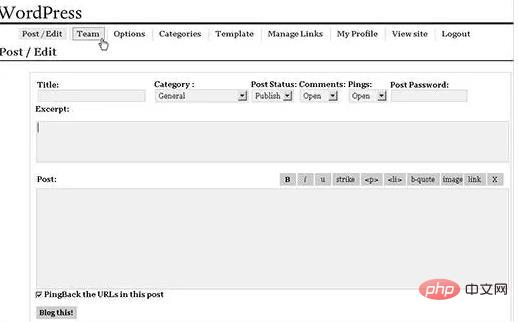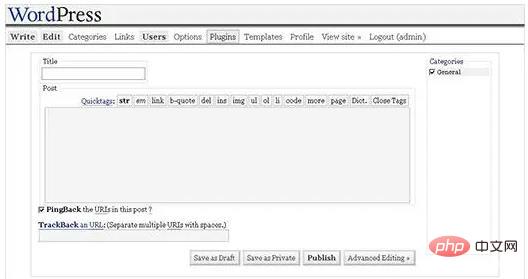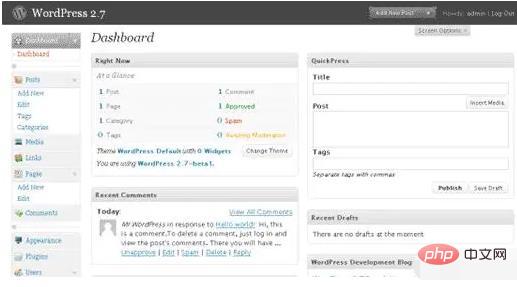What year was WordPress created?
wordpress was released in 2003; Matt announced the first version of WordPress on May 27, 2003, which was welcomed by the community. It was based on b2 Cafelog and had significant improvements; the first version of WordPress Includes new management interface, templates, XHTML 1.1 compatible templates, and content editor.

#The operating environment of this tutorial: Windows 10 system, WordPress 6.1, Dell G3 computer.
Which year is WordPress?
Year 2003.
WordPress is a product created by an open source community without compromising software freedom. Powered by a dedicated community of developers, users and supporters. The reason why WordPress first appeared was because the b2/cafelog blogging software stopped updating. In 2003, two b2/cafelog users, Matt Mullenweg and Mike Little, decided to build a new platform on top of b2/cafelog. They may not know that they are about to embark on a journey that will ultimately benefit millions of users around the world, create thousands of jobs, and make a living from an entire industry of developers, designers, writers, bloggers, and web publishers.
#The development history of WordPress:
<span class="bjh-ul"><span class="bjh-li">#May 27, 2003<span class="bjh-p"><span class="bjh-strong"></span></span></span></span>

# Version 1.2 of WordPress comes with a plugin architecture. This allows users and developers to extend the functionality of WordPress by writing their own plugins and sharing them with the rest of the community.
## With WordPress to the Community Open, something completely opposite was happening in the blogging industry at the time. The market leader in the blogging tools industry at the time was Moveable Type. They announced new licensing terms that many users didn't like. This forces many of their users to look for new blogging platforms.
#WordPress 1.2 as an ambition The Bobo project provides users with a mature, stable, simple and flexible platform with features comparable to its proprietary competitors. WordPress adaptation rates skyrocketed with this release.

As the number of users increases, WordPress starts to get better with the help and interest of the community.
#February 2005

#WordPress 2.0 releases a new admin dashboard. This new admin area is a complete overhaul of the WordPress admin screen. It uses JavaScript and DHTML to create a better user interface where users don't need to load a page to perform some simple tasks. Users can now add categories and tags to posts without leaving the post editor, and can delete comments without reloading the comments page.

## The shiny new admin UI isn't the only big improvement in this release. This is the first version to come with the Akismet anti-spam plugin pre-installed. It also came with a WordPress database backup plugin, wp-db-backup, which was later removed in 2007. Another first for this release is the introduction of the functions.php file in the Theme System.
##March 1, 2006
# Automattic, a company founded by WordPress co-founder Matt Mullenweg, has filed for trademark registration for WordPress and the WordPress logo.
#Year 2008
##family A web design company called Happy Cog has joined the WordPress project to help design a new WordPress admin interface. A usability study was conducted to design the administration UI. Throughout the year, several new features have been added to WordPress such as: shortcodes, one-click updates, and built-in plugin installation.

##June 2010
#WordPress 3.0 released. This is an important step towards WordPress. This version introduces features like custom post types, better custom taxonomies, custom backgrounds, titles, menus, contextual help on the admin screen, and more. The WordPress MU project is merged into WordPress core to create multisite networks. It also comes with Twenty Ten, starting a tradition of a new default theme every year.
#year 2011
#Post Formatting and admin bars come to WordPress. Around that time, some really cool WordPress plugins were building powerful e-commerce platforms on top of WordPress. This enables WordPress users to create online stores and build powerful e-commerce websites using WordPress.
#2012
roll out Theme customizer, theme preview and new media manager. These features greatly help new users create image galleries and preview themes before changing to a new theme.
#year 2013
#WordPress 3.7 comes with a new auto-update feature that allows WordPress to automatically update your website software for minor releases. The auto-update feature is very similar to that of Google Chrome. By far, WordPress has become the most popular CMS in the world.
##December 2013
WordPress 3.8 is released, launching the new WordPress management interface MP6. This new interface is responsive and designed to provide users with a better user experience and will work on any device or screen size.
April 16, 2014
# Then WordPress 4.0 and WordPress Version 4.1 brings more improvements to WordPress core throughout the year.
this This year was also the first year that non-English downloads of WordPress exceeded English downloads.
##2015
#WordPress The 4.2, 4.3 and 4.4 releases. These releases focus on improving localization, emoji support, theme customizer, and laying out the infrastructure for the WordPress REST API.
# That same year, WooCommerce, the most popular WordPress e-commerce plugin, was replaced by Automattic (powered by WordPress The company founded by co-founder Matt Mullenweg) acquired.
##2016
#WordPress 4.5, 4.6 and 4.7 released. Each version introduces some new features and improvements. The most notable changes during the year are streamlined updates for plugins and themes, content recovery using browser storage, and custom CSS capabilities in the theme customizer. By the end of the year, WordPress.org announced active support for HTTP.
##2017 ## WordPress 4.8 and 4.9 released. These versions bring several new default widgets for adding audio, video, images, galleries, rich text, and HTML. These releases also laid the foundation for Project Gutenberg, a new modern publishing experience for WordPress.


The above is the detailed content of What year was WordPress created?. For more information, please follow other related articles on the PHP Chinese website!

Hot AI Tools

Undresser.AI Undress
AI-powered app for creating realistic nude photos

AI Clothes Remover
Online AI tool for removing clothes from photos.

Undress AI Tool
Undress images for free

Clothoff.io
AI clothes remover

Video Face Swap
Swap faces in any video effortlessly with our completely free AI face swap tool!

Hot Article

Hot Tools

Notepad++7.3.1
Easy-to-use and free code editor

SublimeText3 Chinese version
Chinese version, very easy to use

Zend Studio 13.0.1
Powerful PHP integrated development environment

Dreamweaver CS6
Visual web development tools

SublimeText3 Mac version
God-level code editing software (SublimeText3)

Hot Topics
 1386
1386
 52
52
 PHP vs. Flutter: The best choice for mobile development
May 06, 2024 pm 10:45 PM
PHP vs. Flutter: The best choice for mobile development
May 06, 2024 pm 10:45 PM
PHP and Flutter are popular technologies for mobile development. Flutter excels in cross-platform capabilities, performance and user interface, and is suitable for applications that require high performance, cross-platform and customized UI. PHP is suitable for server-side applications with lower performance and not cross-platform.
 How to change page width in wordpress
Apr 16, 2024 am 01:03 AM
How to change page width in wordpress
Apr 16, 2024 am 01:03 AM
You can easily modify your WordPress page width by editing your style.css file: Edit your style.css file and add .site-content { max-width: [your preferred width]; }. Edit [your preferred width] to set the page width. Save changes and clear cache (optional).
 In which folder are wordpress articles located?
Apr 16, 2024 am 10:29 AM
In which folder are wordpress articles located?
Apr 16, 2024 am 10:29 AM
WordPress posts are stored in the /wp-content/uploads folder. This folder uses subfolders to categorize different types of uploads, including articles organized by year, month, and article ID. Article files are stored in plain text format (.txt), and the filename usually includes its ID and title.
 How to create a product page in wordpress
Apr 16, 2024 am 12:39 AM
How to create a product page in wordpress
Apr 16, 2024 am 12:39 AM
Create a product page in WordPress: 1. Create the product (name, description, pictures); 2. Customize the page template (add title, description, pictures, buttons); 3. Enter product information (stock, size, weight); 4 . Create variations (different colors, sizes); 5. Set visibility (public or hidden); 6. Enable/disable comments; 7. Preview and publish the page.
 Where is the wordpress template file?
Apr 16, 2024 am 11:00 AM
Where is the wordpress template file?
Apr 16, 2024 am 11:00 AM
WordPress template files are located in the /wp-content/themes/[theme name]/ directory. They are used to determine the appearance and functionality of the website, including header (header.php), footer (footer.php), main template (index.php), single article (single.php), page (page.php), Archive (archive.php), category (category.php), tag (tag.php), search (search.php) and 404 error page (404.php). By editing and modifying these files, you can customize the appearance of your WordPress website
 How to search for authors in WordPress
Apr 16, 2024 am 01:18 AM
How to search for authors in WordPress
Apr 16, 2024 am 01:18 AM
Search for authors in WordPress: 1. Once logged in to your admin panel, navigate to Posts or Pages, enter the author name using the search bar, and select Author in Filters. 2. Other tips: Use wildcards to broaden your search, use operators to combine criteria, or enter author IDs to search for articles.
 Which version of wordpress is stable?
Apr 16, 2024 am 10:54 AM
Which version of wordpress is stable?
Apr 16, 2024 am 10:54 AM
The most stable WordPress version is the latest version because it contains the latest security patches, performance enhancements, and introduces new features and improvements. In order to update to the latest version, log into your WordPress dashboard, go to the Updates page and click Update Now.
 Does wordpress need to be registered?
Apr 16, 2024 pm 12:07 PM
Does wordpress need to be registered?
Apr 16, 2024 pm 12:07 PM
WordPress requires registration. According to my country's "Internet Security Management Measures", websites that provide Internet information services within the country must register with the local provincial Internet Information Office, including WordPress. The registration process includes steps such as selecting a service provider, preparing information, submitting an application, reviewing and publishing, and obtaining a registration number. The benefits of filing include legal compliance, improving credibility, meeting access requirements, ensuring normal access, etc. The filing information must be true and valid, and must be updated regularly after filing.




